#Rudolf Koch
Explore tagged Tumblr posts
Text










Here are some typeface and monogram designs from the type specimen book Modern Lettering Design and Application edited by Herbert Hoffmann and translated from the German and printed in Germany for New York publisher William Helburn Inc. sometime in the 1930s. Shown here is the work of several noted German type designers and calligraphers, including Heinrich Jost, Rudolf Koch, Ernst Schneidler, Arthur Schulze, Anna Simons, and Emil Rudolf Weiss.
Our copy once belonged to the “Reference Section” of the General Society of Mechanics and Tradesmen of the City of New York, and and you can see its ownership stamp on the last image. This copy also bears the ownership stamp of Hayward Cirker the founder of Dover Publications.
View another post from this publication.
View our other Typography Tuesday posts.
#Typography Tuesday#typetuesday#Herbert Hoffmann#Modern Lettering Design and Application#Anna Simons#Rudolf Koch#Heinrich Jost#Ernst Schneidler#Arthur Schulze#Emil Rudolf Weiss#William Helburn Inc#General Society of Mechanics and Tradesmen of the City of New York#Hayward Cirker#type designers#20th century type
76 notes
·
View notes
Text
So we've got Meetings in the Outrealm: Series V (for those of you who've forgotten, it's the "beat a boss in co-op" set of the achievements) now, and I think it's a good time to look back on the five Outrealm achievement namecards we've got and their connections to lore.
(Long post warning. Go grab a snack and some water, like I forgot to do when writing this post)
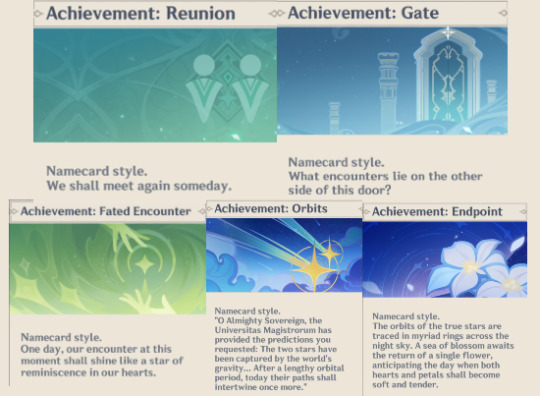
Achievement: Reunion - We shall meet again someday.
Released in Version 1.0. Pointedly, predates Chapter I Act IV: We Will Be Reunited (Version 1.4), but carries the exact same theming— the Traveler twins will meet again.
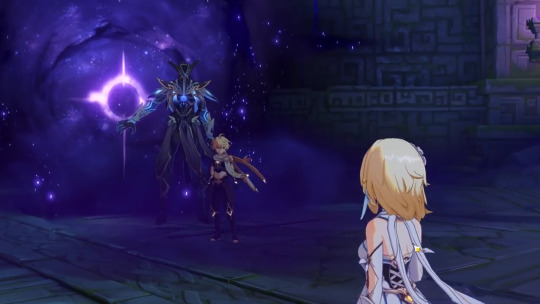
So we'll meet again. Though we need not rush, (brother/sister). I have more than enough time to wait for you.
It's my belief that, from this point forward, all the "Meetings of the Outrealm" achievements foreshadow, or at least echo, the themes of the Traveler Archon Quests, as well as other relevant Traveler lore we learn.
2. Achievement: Gate - What encounters lie on the other side of this door?
Admittedly, this one immediately breaks my presumption because it bears very little resemblance to anything I can remember of Chapter II Act IV: Requiem of Echoing Depths. The door depicted in the namecard (released Version 2.0) is obviously the loading screen door, which is located in the same sky-heaven area (suspected to be Celestia but we're not sure) in which the twins encountered the Sustainer of Heavenly Principles by trying to leave Teyvat.
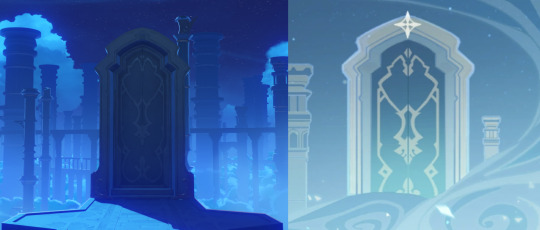
There is one crucial difference between the two depictions, which is the four-pointed star/primogem present on top of the door in the namecard. It's not present on the loading screen (I know the screenshot above is night-time which makes it hard to see, but I'm pretty sure the symbol is different). The symbol is obviously so well-known and thematic everywhere in Genshin that I'm not surprised it's here; notably instances of its use, apart from in primogems and Khaenri'ahn eyes/neck, includes: the "eye" in the Traveler's original wings, the logo of WWBR (representing each twin) and on the front of Lumine's dress/back of Aether's cape.
The fact that the same symbol now hangs over the door that brings us into the world of Teyvat raises several questions and possible ideas that aren't within the scope of what I want to say. In this context where the Outrealm achievements are very clearly Traveler lore-themed, I'll just suggest that the door to Teyvat with the four-pointed star represents that the purpose of our journey, at least in Teyvat initially, is to search for our sibling (this becomes less relevant later on, but is still generally true).
Also, Rudolf Koch's Book of Signs suggests that the four-pointed star "is a phenomenon carrying a grave and solemn warning", so there's also a more sinister outlook to the door in the namecard.
I think the link with Requiem of Echoing Depths might be loosely based on "encounters on the other side of the door" theme. Dainsleif emerges from a portal (a more metaphysical 'door') at the beginning of the quest, just as our twin disappeared into one at the end of WWBR. The door is a symbol and gateway of both the unattainability of our twin, and the regular encounters we have on our journey in Teyvat.
And, if you want to stretch it a bit further into the future, the door to Khaenri'ah in Hangeh Afrasiyab, released in Version 3.6, carries on this theme of doorways and encounters— you cannot enter it at the moment of writing, but the existence of such a door is a reminder of Khaenri'ah. What sort of encounters did your sibling have behind this door, in the kingdom underneath the ground? You don't know, and that's part of the mystery that separates the two of you, and why in Requiem, you two share such differing beliefs on why or why not the purification device should be activated.
---
3. Achievement: Fated Encounter - One day, our encounter at this moment shall shine like a star of reminiscence in our hearts.
4. Achievement: Orbits - "O Almighty Sovereign, the Universitas Magistrorum has provided the predictions you requested: The two stars have been captured by the world's gravity… After a lengthy orbital period, today their paths shall intertwine once more."
I'm putting these two together (released in Version 3.0 and 4.0 respectively) because I think the corresponding Traveler acts, Caribert (Version 3.5) and Bedtime Story (Version 4.7), correlate inversely with the release dates of these namecards.
For example, Orbits and 3.X lore:
In Version 3.3's Archon Quest Interlude Inversion of Genesis, we indirectly hear the words of Pierro (a Khaenri'ahn) on the topic of our sibling, retold to us through Scaramouche.
The reason why there are records about your (sister/brother) in Irminsul… It might have something to do with Khaenri'ah. Apparently, Khaenri'ah was (her/his) first destination when (she/he) arrived in this world. Plus, (she/he) only came to this world because the heavens responded to the summoning.
Later on in Caribert, Chlothar Alberich, Khaenri'ahn and founder of the Abyss Order, tells us:
We once believed that you [the Traveler's sibling] would bring new strength and hope to Khaenri'ah. To us, you were the Abyss... A wondrous mystery far beyond our imagination and comprehension...
Setting aside debates on what the Abyss actually is, all of the above dovetails with Achievement: Orbits, which clearly depicts two primo-stars representing the twins in 'orbit', and the Khaenri'ahn organisation Universitas Magistrorum talking about them, suggesting they are somehow scrying the fates of the two who have been 'captured by the world's gravity'. Given that it is all but directly stated that Khaenri'ah summoned the twins (or, perhaps, just the sibling depending on how you look at it), the namecard is basically the Khaenri'ahn perspective of everything we learn in Version 3.X.
Perinheri (a book released in 4.5) also tells us that Khaenri'ah awaited the arrival of beings who could transcend the gods, and this dovetails nicely with Orbits and Chlothar's statement to support the hypothesis that the twins were summoned, or at least, scried on and waited for. The implication that the 'Almighty Sovereign' (explicitly, a royal, likely the king, in CN) requested this scrying almost confirms it.
While the text obviously means that this hypothetical comment must have been made when Khaenri'ah still, well, existed, it also thematically resonates with all quests where the Traveler does reunite with their sibling in some form, most prominently in WWBR, but also Requiem of Echoing Depths (via mirage), Caribert (via memory and shattered mirror), and Bedtime Story (via Caribert's realm, and subsequently forgotten).
---
Meanwhile, Achievement: Fated Encounter ironically suits the themes of Version 4.X Traveler lore better.
Let's get the big one out of the way first. Chapter IV Act VI: Bedtime Story is a cruel, cruel subversion of the namecard's theme— because no. Your reunion will not shine like a star of reminiscence in your heart. You will not remember it at all. Narratively, I find it neat that 13 versions after Rukkhadevata's wiping from Irminsul, the audience is now thrust into the same position as the Traveler: as the only one who 'remembers'. As the witness to something wiped from history. (Can you tell this makes me emotional?) As an audience member, this moment is for you, you will remember it, and nobody else. Even the phrasing of "one day..." suggests that only at some nebulous point in the future will this reunion become remembered.
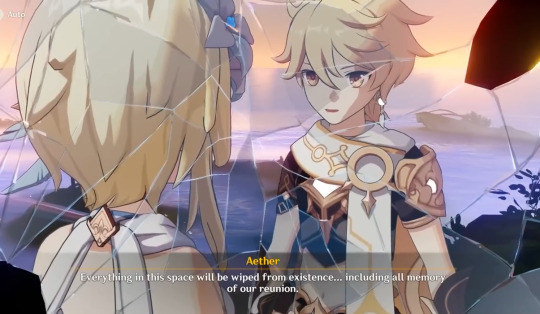
Hell, the namecard is two hands hovering over a four-pointed star. Given the symbolism of the primo-star as representative of both "your twin" and "warnings of an encounter" (roughly), it is basically a perfect set-up for Bedtime Story; not withstanding that the symbolism also suits the events of Caribert, where we're jumpscared with our twin in a shattered mirror, suiting the portend of an omen (the first and last quests in Caribert are named Destined Encounter and Portended Fate, neatly tying this together as well).
Of course, Fated Encounter's text harkens back to WWBR itself, as both the 'fated encounter' and becoming the moment upon which we reminisce.
The reason I think it fits better with 4.X Traveler content is because of where else we get moments of reminiscence of the Traveler and their twin: notably, in Wriothesley's SQ, Reborn in the Land of Grievances, and Xianyun's SQ, A Thousand Moonlit Miles.
For context, recall that Wriothesley's SQ is about a 'fear gem', which the villain is using to control a society of people to do his bidding by injecting them with liquid fear. Traveler and Wriothesley pick up the gem containing this liquid at the beginning of this quest, and touching it causes unpleasant flashbacks of, essentially, moments that create fear. For the Traveler, these four images are shown when they touch the gem:

Top left is vs Sustainer from the opening of the game when their twin is taken away. Top right is from Caribert, where Traveler realises they have been experiencing a memory from the perspective of their twin. Bottom two are images from the Defiled Statue room in WWBR, including the dead Grand Thief.
It is almost self-explanatory why these are a record of moments when Traveler felt 'fear'. I think this works particularly well as a thematic reflection of Achievement: Fated Encounter because this is a negative-context reminiscence of said 'fated encounters'. Here, Traveler is recalling these moments with a very strong negative association due to fear.
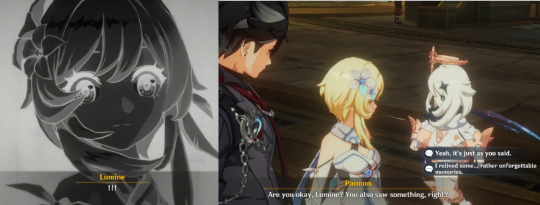
Compare and contrast with Grus Serena Act I's ending cutscene, where due to Xianyun's 'positive dream' Suspensus Somnium Mechanism, we get this lovely scene with the Traveler dreaming of reuniting with their twin:

Now, this is explicitly a dream, which isn't real and hasn't happened. I would argue, however, that regardless of whether this is real, this is the second important Traveler scene in Version 4.X before the release of Bedtime Story, serving to both set the emotional stakes, and as the positive counterpoint to the theme of reminiscence touched on in Wriothesley's Story Quest.
Thematically, this is the other side of the 'star of reminiscence' in Achievement: Fated Encounters. While the scene in Xianyun's SQ is a bittersweet dream, ending up with the Traveler waking up in tears and thus is not a straightforward positive happiness, this melancholic nostalgia for a more innocent existence in Grus Serena Act I still contrasts with the sharp burst of fear we're served with the images of our past experiences Cerberus Act I. They are two sides of the same coin and a reflection of the conflicting myriad of feelings the Traveler has about their twin— longing, heartbreak, fear, confusion— exploring what the memory of their twin means to them. Shine like a star of reminiscence in our hearts much?
Also, you encounter the gem of negative reminiscence at the beginning of Wriothesley's SQ, and the dream of positive reminiscence at the end of Xianyun's SQ. You could possibly stretch this to reflect the journey as a whole— which begins with fear, loss, and confusion, and ends with bittersweet happiness. Wait, shit, does that mean one of the twins is going to die—
Essentially, it's all about memory. Which also echoes Bedtime Story and how Caribert attempts to connect with others, however briefly, through his incomplete Loom of Fate, trying to 'live' like a real person even though he cannot exist as anything but a memory in people's minds— I would make a slight tie with Nara Varuna (the twin, as referred to by the Aranara), but I'm running out of short-term memory storage to load Aranyaka lore, so I'll try again later.
(Cheekily, the four-pointed star in Achievement: Fated Encounter is actually part of the co-op mode symbol, which is the star plus radiating waves resembling a WiFi symbol. You could point to this just being an acknowledgement of the fact this namecard is obtained from playing in co-op mode, but apart from what I've discussed, I can add a suitably unhinged suggestion that the co-op mode icon contains lore. It's a modification of a WiFi icon, which popularly depicts a dot as a broadcast origin, and concentric waves surrounding it as the signal broadcasting from it. Simple, but Genshin replaces the dot of broadcast origin with a four-pointed star, ostensibly just representing the game's version of connectivity. And yet, the four-pointed star broadcasting a signal outwards can also use the symbolism of the Traveler/the Twin as the point of origin as a reach for 'connection', both reaching for their sibling, and as a general harkening back to the theme of the Traveler being a 'connector' of people's wills, a la Liyue finale, Inazuma finale, Sumeru finale— wait, I'm sensing a pattern here...)
Of course, let me not forget to mention that Achievement: Orbits is also relevant to Bedtime Story and some of 4.X. That quest is where Dainsleif casually drops the Five Sinners of Khaenri'ah on us, so it ties in with the disembodied quote we get about Khaenri'ah addressing the twins. We also learn about the Universitas Magistrorum from the Narzissenkreuz WQ series beginning from 4.0, where it is stated that they 'inverted the alchemical stages' (likely referring to how, in real life, the alchemical stages of Magnum Opus, the process of creating the philosopher's stone, were Nigredo -> Albedo -> Citrinitas -> Rubedo, whereas from Albedo's ascension voicelines, we know his Art of Khemia, originating from Khaenri'ah, inverts Citrinitas and Rubedo, suggesting that the irl Magnum Opus is actually the lore-accurate method as opposed to what the Art of Khemia says about Rubedo -> Citrinitas. But that's a story for another time). While unrelated to twins lore specifically, the gradual addition of Universitas Magistrorum lore might serve a purpose like the continual drip-feeding of Qiaoying Village pre-4.4, as well as Dornman Port and Blackcliff Forge now, building up to eventual relevancy. For now, there's no way of knowing.
---
...wait, why did I make this post again?
(nervously checks notes) ah right, to dissect the Outrealm achievement series. So, let's look at what we have for 5.0.
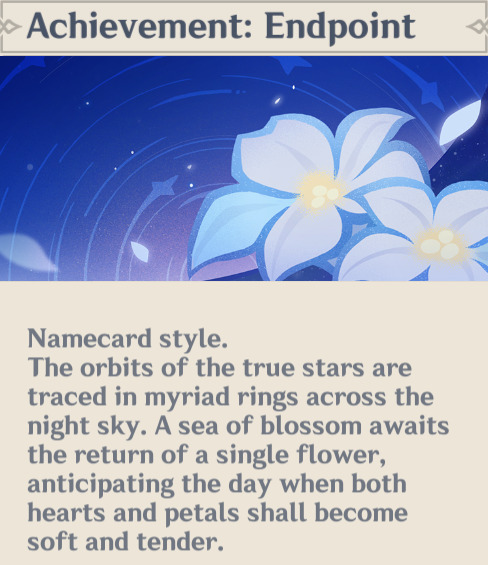
While I won't suggest we can predict the plot of the next Traveler Chapter through this namecard alone, we can go through the themes and plot points brought up by this namecard, and see where it gets us.
Obviously we are tying back with Bedtime Story here. That is where we first learn that the "Sea of Flowers at the End" is a real place (and not just Travail's artistic concoction of the finale of the game)— both the title of Achievement: Endpoint and the depiction of Inteyvats reinforces that this is where our journey will end.

You: Why... Why can't we continue our journey together? Sibling: At the end of my journey, I arrived at a place known as "The Sea of Flowers at the End." Do you remember? A long time ago, when we traveled between worlds together... You told me… You wanted to find a place in the universe where that one flower was in full bloom. To have a place like that suddenly appear before me… Well, would you think of that as a coincidence?
It is all but outright stated the reason our sibling cannot move on from Teyvat and travel with us is (aside from the war with the Heavenly Principles) because Teyvat contains the true endpoint of their journey, not just the journey through the land itself but their journey through the cosmos at large— the Sea of Flowers, which is the location we will reach at the end of the game.

The Sea of Flowers is a field of seemingly-endless Inteyvats and, contrary to my belief before 4.7, an actual physical (or at least metaphysical) location. Achievement: Endpoint says of this place "a sea of blossom awaits the return of a single flower, anticipating the day when both hearts and petals shall become soft and tender".
Breaking this down, we can identify that the return of a single flower should refer to Lumine, regardless of whether she is your Traveler or your twin, since she wears the Inteyvats in her hair. This creates two completely different narratives about the game depending on who you picked, which seems mostly antithetical to how Genshin has written the siblings thus far. (Well, she wears Inteyvats plural on her hair, so the single flower thing shouldn't apply.)
So let's skip that and contextualise the rest. If the Sea of Flowers is waiting for an Inteyvat to 'become soft and tender', then there is a condition we need to fulfill. Recall Dainsleif's words in Requiem of Echoing Depths about the Inteyvat:
But if you were to pluck one and take it out of Khaenri'ah, the petals would stop growing and turn hard. Only when it finally returned to its home soil would the petals grow soft once more, and finally turn to dust... So the Inteyvat is a symbol for a wanderer far from home, signifying the tenderness of the homeland.
The symbolism is incredibly blatant. The Sea of Flowers awaits the day when the return of a single Inteyvat, because only when the flower returns to its homeland will it grow soft.
Here's where we resolve the Lumine problem. The name of this flower is the Inteyvat. Prefix in-, which English borrows from Latinate words, where the prefix was used in a variety of ways but in our case, to mean "not-". Therefore Inteyvat, as in "not-Teyvat", or more fancifully, "not of Teyvatian origin".
If the returning flower is an Inteyvat, it is not actually about who carries the flower, but what the name of the flower represents: "not-Teyvat". Which means it should be your chosen Traveler, regardless of gender, because your twin has become "part of this world" for a reason unknown to us, and no longer counts as an external being, or Descender— we learn as such from Inversion of Genesis.
Nahida: Irminsul does not keep records on the Descenders. Anyone who comes from beyond this world is not counted as part of Teyvat. Scaramouche: The reason why there are records about your (sister/brother) in Irminsul… It might have something to do with Khaenri'ah. Apparently, Khaenri'ah was (her/his) first destination when (she/he) arrived in this world.
Essentially, this is a giant lore teaser for: you're going to the Sea of Flowers at the end, and everyone will be happy again...
Or, not?
Because Endpoint tells us that it awaits the day when both hearts and petals shall grow soft and tender. This is a yearning for the softness and happiness of reuniting without anything standing in the siblings' way, except... Dainsleif explicitly tells us that after the flower returns, it doesn't just go soft— it turns to dust.
This is why, earlier, I suggested that theory about the emotional overtones of our journey, as derived from Wriothesley and Xianyun's SQs. Without the supporting evidence of the Inteyvat's dissolution implied at the end, it's just crack; but now, I think it's going to compose the bittersweetness of the reunion or ending we're promised, like Xianyun's SQ depicts.
(I want to be clear that this isn't a prediction of Traveler or twin dying. While it certainly isn't outside the realm of possibility, I wouldn't lock in the Inteyvat dissolution symbolism into that event alone; it's also possible, for instance, that one or both of them lose their memories, etc, or they lose something else dear to them. We can't even be sure the story will end on such a note anyway, so this is purely extrapolation on extremely limited connections.)
As a mini-prediction: we could either get more Sea of Flowers lore in Natlan's Traveler Chapter (unlikely, doesn't seem Hoyo's style to follow-up so soon, we still don't understand the Defiled Statue etc.), or we could follow the emotional beats implied by the namecard description. Or, like Achievement: Gates and Requiem, it could have loose or no connections at all.
This post is mostly an excuse for me to talk about my favourite lore in the game. I'm going to bed
#genshin impact#genshin lore#genshin lumine#genshin aether#genshin traveler#i'm so normal about them#genshin impact lore
91 notes
·
View notes
Text
Kabel was designed by Rudolf Koch and released by Klingspor in 1927, back when Germany was still using Fraktur, and sans serif fonts were considered revolutionary (if not subversive).


The example above uses ſ (long s) and ligatures for ch and ck, both of which are carried over from fraktur conventions.
At first glance it might look like a boring default sans serif font like Arial or Helvetica, but it actually has some subtle idiosyncracies, like the slanted e and the open g. (Though in 1953, a modified version called Neu-Kabel was released, which replaced both of these letters with more mainstream shapes, with the apparent goal of making Kabel as boring as possible.)
Here's an article on the history of Kabel. Also, Wikipedia has an article on Kabel. Also also, Fonts In Use has examples of Kabel in use.

Virginia Slims advertisement, 1988
261 notes
·
View notes
Text
And then we come to this bag of rancid flesh.
Waldemar Hoven was a nazi physician at Buchenwald concentration camp, and convicted war criminal for conducting human experiments regarding typhus which led to the deaths of many concentration camp prisoners, and as one of the organizers of the euthanasia program Aktion T4; this nazi initiative resulted in the systematic murder of 275,000 to 300,000 disabled people. He was sentenced to death and hanged on 2 June 1948.
Sounds like a lovely person, yes?
Gag.
Between 1919 and 1921, Hoven visited Denmark and Sweden to study agriculture. In the 1920s, he visited the United States, where he worked as a movie extra in Hollywood. How weird is that?
In the 1930s, Hoven went to Paris, where he had an affair with an American woman who gave him an extremely valuable gold cigarette case. Hoven finally returned home to Freiburg in 1933, where he completed his high school studies. He then attended the Universities of Freiburg and Munich. In 1934, he joined the SS. In 1939, he concluded his medical studies and became a physician for the SS. Hoven rose to the rank of Hauptsturmführer (Captain) in the Waffen SS.
After completing his basic training in the Waffen SS, he became assistant medical officer in the Buchenwald concentration camp and held this position until 1941; in January 1941 he became the second camp doctor of Buchenwald, and became chief camp physician at least as early as June 1942.
Hoven was involved in the administration of medical experiments regarding typhus and the tolerance of serum containing phenol, and which led to the deaths of many inmates. He was also involved in the Aktion T4 programs, during which people with disabilities were killed, along with Jewish people who were considered unfit for work. According to other prisoners, Hoven was murdering 90 to 100 prisoners every week, for a year and a half, with phenol injections.
(In modern times, phenol injections are used to help with cancer pain. What does it do? It destroys the nerves.)
It gets weirder...
He was arrested by the nazis on 12 September 1943, accused of giving a lethal injection of phenol to Hauptscharführer Rudolf Köhler, an SS officer who was a potential witness in an investigation against Ilse Koch, with whom Hoven was rumoured to be having an affair. Hoven was charged with murder, but the case was delayed. He was released on 15 March 1945 due to the shortage of doctors.
Hoven was arrested at the end of World War II by the Allies and put on trial as a defendant at the Doctors' Trial, one of the Nuremberg Trials. He was found guilty of war crimes, crimes against humanity and membership in a criminal organization (the SS). He was sentenced to death and hanged on 2 June 1948 at Landsberg Prison in Bavaria. Swiiiiiiing.
If I remember right, he was 6th in line of the men that were hanged in the Doctor's trial, right along with Brandt and Gebhardt. Bastards, the whole lot of them.

1 note
·
View note
Text
Städel Museum - Kunst der Moderne
Ich mache eine kurze Frischluftpause und steige hinauf zum Städeldach. Von hier hat man einen exzellenten Blick über den Main. Weiter geht es zur Kunst der Moderne: 1800 bis 1945 Landschaft mit Dankopfer Noahs • Joseph Anton Koch • 1803 Der Einzug des Königs Rudolf von Habsburg in Basel 1273 • Franz Pforr • 1808/10 Der Graf von Habsburg und der Priester (Ausschnitt) • Franz Pforr •…

View On WordPress
0 notes
Video
youtube
Test 7 Çağdaş Yayıncılık Aykut ilter Tipografi I 7. ÇAĞDAŞ YAYINCILIK YazdırTüm Cevapları GizleMateryal Listesine Dön ________________________________________ Soru 1: II. Dünya Savaşı sonrasında Batı dünyasının önemli kültür ve sanat merkezi hangi metropol olmuştur? (Çoktan Seçmeli) Londra, Paris, ✔ New York, Roma, Berlin Cevap : New York, ________________________________________ Soru 2: Savaş döneminde askeri amaçlarla çeşitli karmaşık hesaplamaları yapabilmek için geliştirilen cihaz, aygıt veya donanım hangisidir? (Çoktan Seçmeli) Radyo, Televizyon, Teleks, ✔ Bilgisayar, Cep telefonu Cevap : Bilgisayar, ________________________________________ Soru 3: 1948’de bilgisayarların geliştirilmesini ve daha sonraki yıllarda bilgisayar çağının başlamasını sağlayan buluş hangisidir? (Çoktan Seçmeli) Radyatör, ✔ Transistör, Jeneratör, Formatör, Gladyatör Cevap : Transistör, ________________________________________ Soru 4: 1961’de kuru aktarım (dry transfer) yöntemiyle instant lettering (anında veya hazır yazı) ürünü ilk olarak hangi kuruluş tarafından piyasaya sunulmuştur? (Çoktan Seçmeli) Trinitron, Chartpak, DecaDry, MecaNorma, ✔ Letraset Cevap : Letraset ________________________________________ Soru 5: Adrian Frutiger tarafından ‘Univers’ yazı karakteri hangi yıl tasarlanmıştır? (Çoktan Seçmeli) ✔ 1957, 1958, 1959, 1960, 1961 Cevap : 1957, ________________________________________ Soru 6: 1960’ların sonunda görüntülük (ekran) gösterimi üzerindeki işlemlerde bir imleme – ya da belirtme – aracı olarak Douglas Englebert tarafından geliştirilen cihaz hangisidir? (Çoktan Seçmeli) Tablet, Computer, Printer, Plotter, ✔ Mouse Cevap : Mouse ________________________________________ Soru 7: Hangi dizgi teknolojisi “soğuk dizgi” olarak adlandırılır? (Çoktan Seçmeli) Linotype, Monotype, ✔ Typewriter, Intertype, Ludlow Cevap : Typewriter, ________________________________________ Soru 8: II. Dünya Savaşı ve sonrasında Amerikan grafik tasarımında iz bırakan ancak göçmen olmayan sanatçı/tasarımcı aşağıdakilerden hangisidir? (Çoktan Seçmeli) ✔ Joseph Binder, Herbert Bayer, Laszlo Moholy-Nagy, Herbert Matter, Ladislav Sutnar Cevap : Joseph Binder, ________________________________________ Soru 9: Aşağıdaki sanatçı/tasarımcılardan hangisi “İsviçre Okulu” tarzının temsilcisi değildir? (Çoktan Seçmeli) Josepf Müller-Brockmann, Max Huber, Anton Stankowski, ✔ Jean Carlu, Armin Hofmann Cevap : Jean Carlu, ________________________________________ Soru 10: ‘Palatino,’ ‘Melior’ ve ‘Optima’ gibi yaygın olarak kullanılan en önemli yazı karakterlerini 1950’lerde tasarlayan ünlü kaligrafi ve tipografi sanatçısı kimdir? (Çoktan Seçmeli) Rudolf Koch, ✔ Hermann Zapf, Edward Johnston, Max Miedinger, Adrian Frutiger Cevap : Hermann Zapf, Tipografi,ÇAĞDAŞ YAYINCILIK,kültür ve sanat merkezi,New York,Transistör,dry transfer,kuru aktarım,instant lettering,anında veya hazır yazı,Letraset,Adrian Frutiger,Univers,yazı karakteri,görüntülük (ekran),imleme – ya da belirtme,mouse,“soğuk dizgi”,Joseph Binder,“İsviçre Okulu”,palatino,melior,optima,Hermann Zapf,grafik tasarım,tipografi dersi,test çözümü,soru cevap,öğrenci soruları,final,bütünleme,vize,ders notları,final soruları,vize soruları,test
0 notes
Text
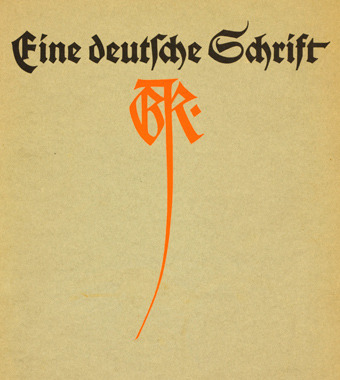
Rudolf Koch Deutsche Schrift (Meggs, 672)
0 notes
Photo
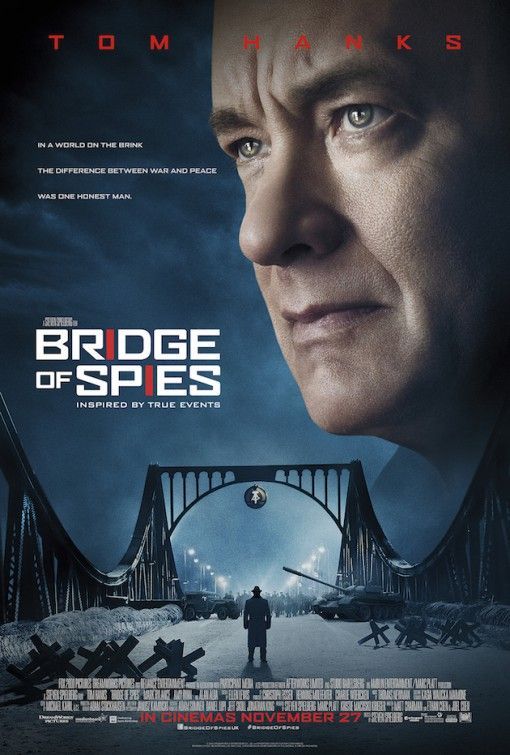
Title: Bridge of Spies
Rating: PG-13
Director: Steven Spielberg
Cast: Tom Hanks, Mark Rylance, Amy Ryan, Alan Alda, Sebastian Koch, Austin Stowell, Billy Magnussen, Michael Simon Hall, Edward James Hyland, Stephen Kunken
Release year: 2015
Genres: thriller, drama, history
Blurb: During the Cold War, the Soviet Union captures U.S. pilot Francis Gary Powers after shooting down his U-2 spy plane. Sentenced to ten years in prison, Powers’ only hope is New York lawyer James Donovan, recruited by a CIA operative to negotiate his release. Donovan boards a plane to Berlin, hoping to win the young man’s freedom through a prisoner exchange. If all goes well, the Russians will get Rudolf Abel...the convicted spy Donovan defended in court.
#bridge of spies#pg13#steven spielberg#tom hanks#mark rylance#amy ryan#alan alda#sebastian koch#2015#thriller#drama#history
4 notes
·
View notes
Text
DRAGON'S EYE
STRAY KIDS “LEVANTER” MV

The “Dragon's eye” is an ancient Germanic symbol as collected by Rudolf Koch. The “Dragon's eye” is an isosceles or equilateral triangle pointing downward, with a “Y” in the middle connecting the three points of the triangle together.

According to Carl G. Liungman’s Dictionary of Symbols, it combines the triangle meaning threat and the “Y” meaning a choice between “good” and “evil”
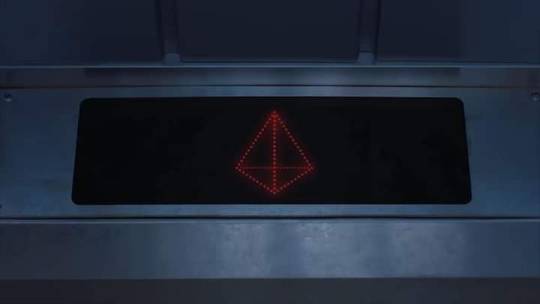
The “Dragon's eye” is a well known symbol of protection, said to protect anyone who recited the incantation to it. The dragon is a universal motif linked to various cultures of humanity for 5,000 years.
The word dragon comes from “Derkesthai” (Greek: to glance dartingly) which, in a Hindu tradition, was the hungry look of the very first being when its fiery spirit was born out of the abyss of water.
The “Dragon's eye” symbol stands for the balance of love, power, and wisdom.
Wikipedia
0 notes
Photo






We have made a deal to purchase a set of twelve art prints, created apparently in the middle to late 1970s for Interatom in Germany. We hope to exhibit these at the World Science Fiction Convention in Washington, DC this year. The Worldcon closes on 19 December, and 20 December is the 70th anniversary of the first production of electricity from fission, at EBR-I in Idaho.
―Part 2―
2 notes
·
View notes
Text










Typography Tuesday
Today we present some type specimens from a recent acquisition, Berthold-Schriften No. 399A, published in Stuttgart by the Berthold Type Foundry in the early 1950s. Berthold, founded in Berlin in 1858 by Hermann Berthold as a brass rule manufacture and casting metal type after 1893, was one of the largest and most successful type foundries of the 20th century. Monotype acquired all of Berthold's inventory in 2022. The typefaces shown here are:
Fanfare schmal (condensed), designed by Louis Oppenheim (1879–1936) and released by Berthold in 1927.
Bücher-Grotesk halbfett, among Berthold's Akzidenz-Grotesk family of typefaces, released in 1898, a few years after Berthold began casting metal type.
Vertikal by an unknown designer.
Block Signal, designed by Walter Wege (1894-1972) and released by Berthold in 1932.
Berthold Block, designed by Hermann Hoffmann (1856-1926) and released by Berthold in 1908.
Post-Antiqua, designed by Herbert Post (1903-1978) and cut by Paul Koch the son of Rudolf Koch, cast by Berthold in 1932.
Bergwerks-Zeichen (mining sign), hammer and chisel symbols in various sizes.
View our other Typography Tuesday posts.
#Typography Tuesday#typetuesday#Berthold Type Foundry#Berthold-Schriften#Berthold-Schriften No. 399A#typefaces#type specimens#type specimen books#type display books#Fanfare schmal#Louis Oppenheim#Bücher-Grotesk#Akzidenz-Grotesk#Vertikal#Block Signal#Signal type#Walter Wege#Berthold Block#Hermann Hoffmann#Post-Antiqua#Herbert Post#Paul Koch#20th century type
72 notes
·
View notes
Text


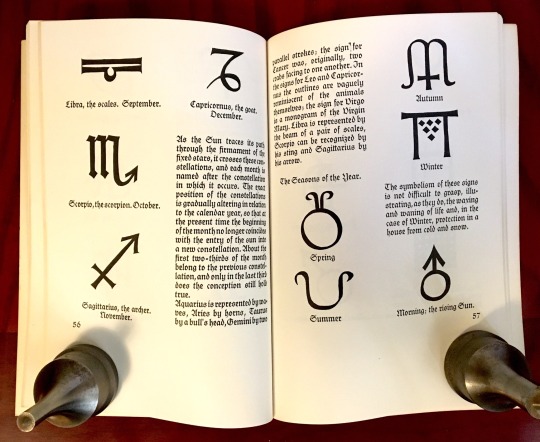
Book 115
The Book of Signs
Rudolf Koch
Dover Publications - no date
Another great reprint from Dover. The Dover edition was first published in 1955, but I have no idea what year my copy was printed.
#bookseller#bookshelf#collection#library#personal collection#personal library#books#bibliophile#book lover#illustrated book#booklr#book of signs#rudolf koch#reference#dover books#graphic design
0 notes
Link
0 notes
Photo


#die nibelungen#siegfried#kriemhild's revenge#paul richter#margarete schön#hanna ralph#bernhard goetzke#theodor loos#rudolf klein rogge#rudolf rittner#hans adalbert schlettow#georg august koch#georg john#gertrud arnold#Hans Carl Müller#erwin biswanger#fritz alberti#Annie Röttgen#fritz lang#1924
110 notes
·
View notes
Text
watch me derail my creativity with one tiny innocent google search
#that mid writing urge to research your facts#its the rabbit hole every fucking time#writing things#writing#creative process#today it was rudolf koch#tomorrow who knows
2 notes
·
View notes
Photo








Books recommended by Poet Scarlett Sabet or Led Zeppelin's Jimmy Page.
Photo: Google Image search
#scarlett sabet#jimmy page#jimmy page girlfriend#led zeppelin#poet#milan kundera#royston ellis#paul stanley#william burges#isabel hickey#aleister crowley#rudolf koch
6 notes
·
View notes